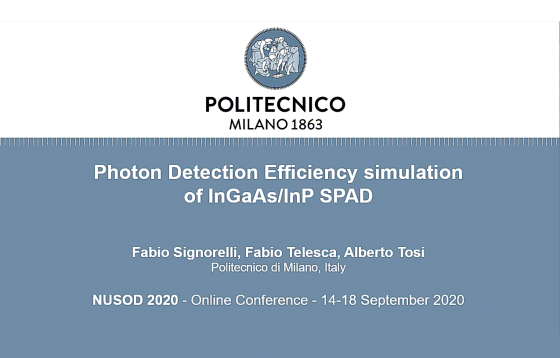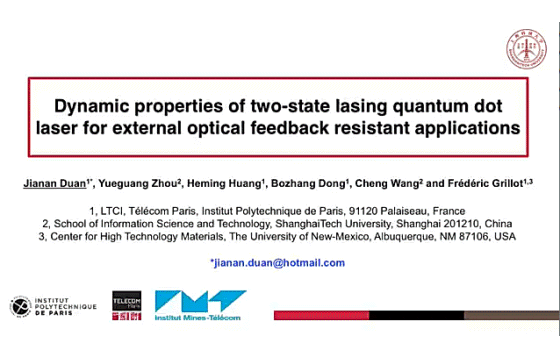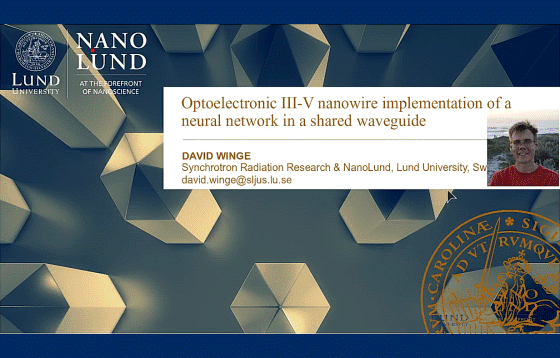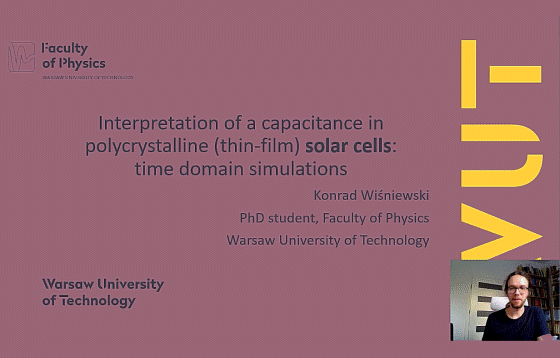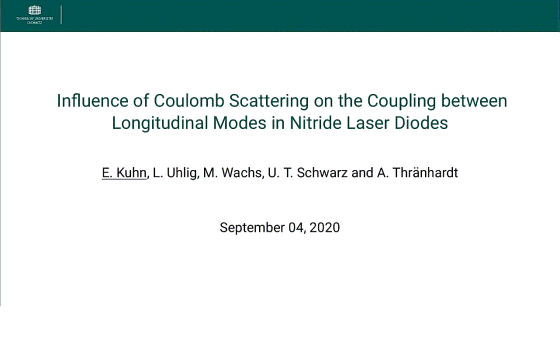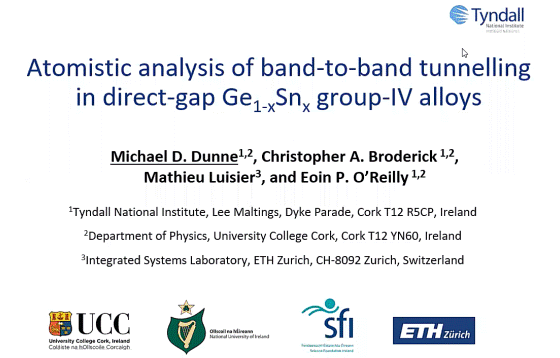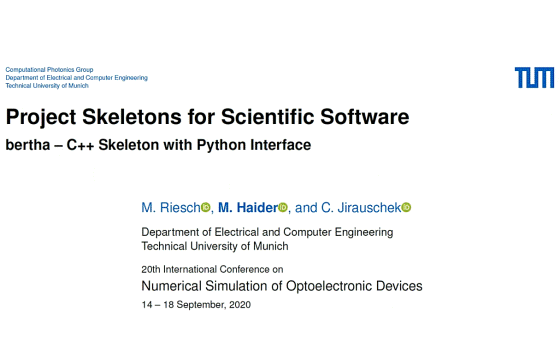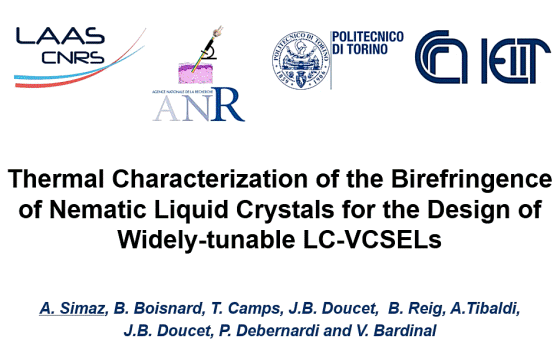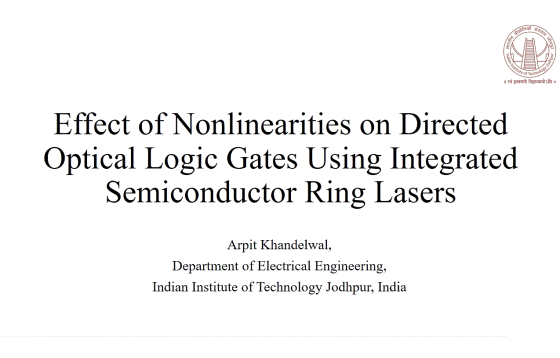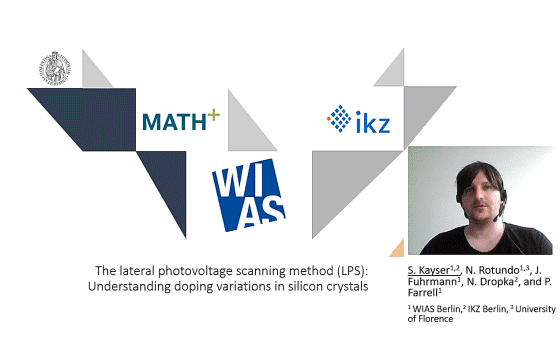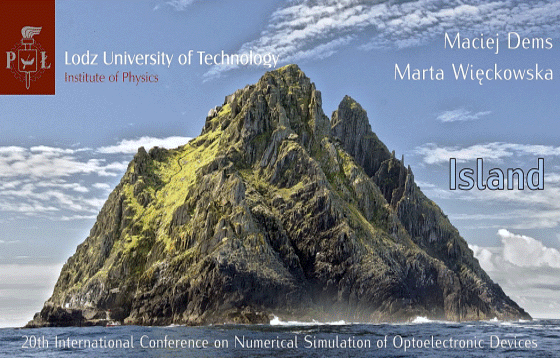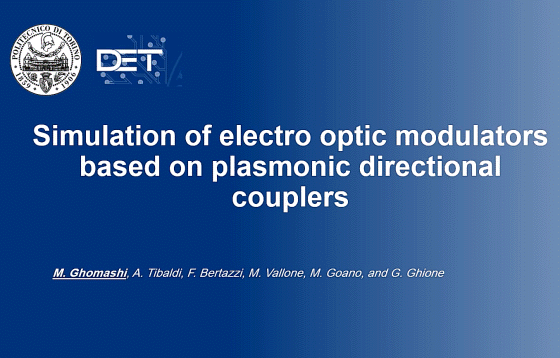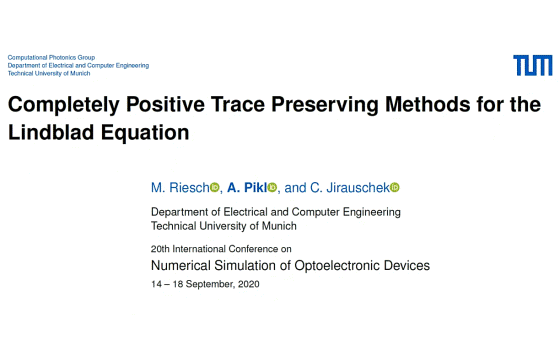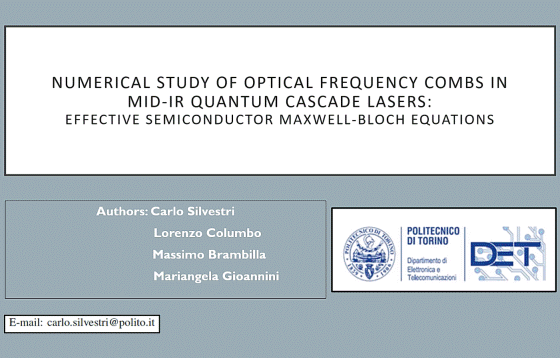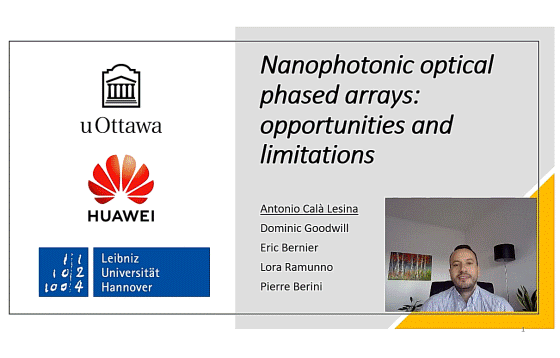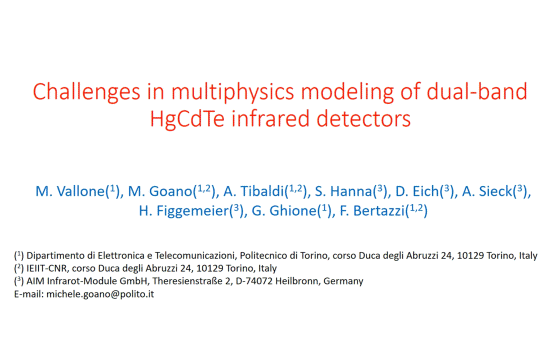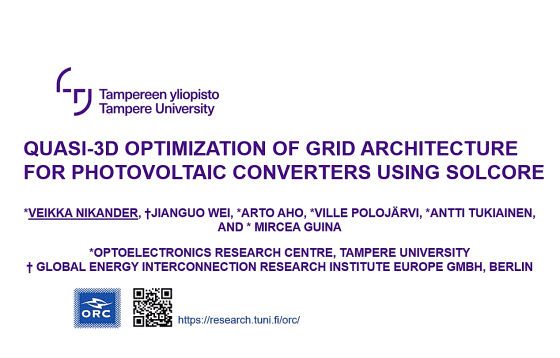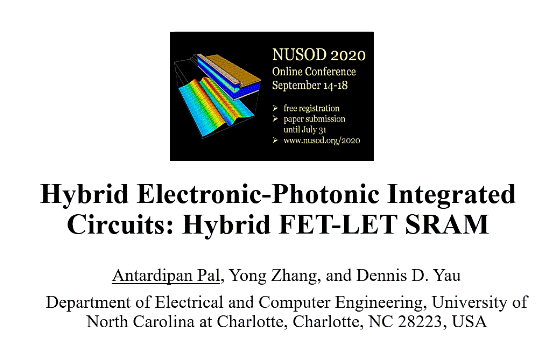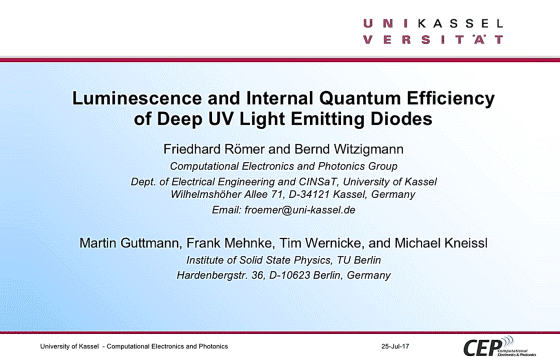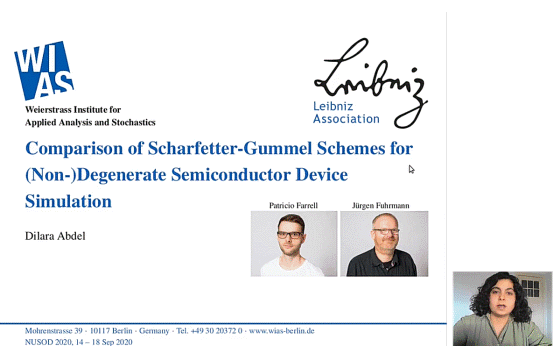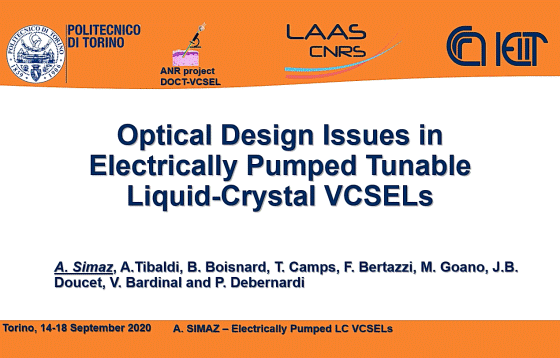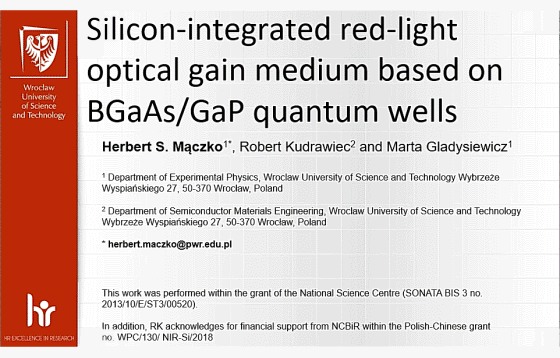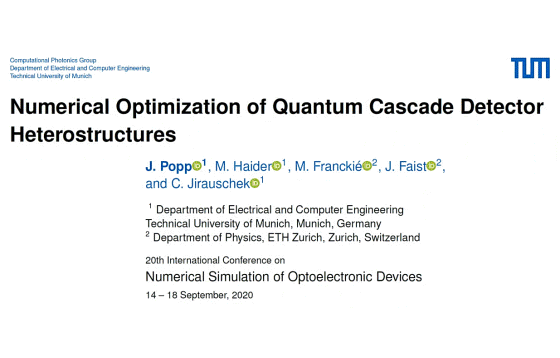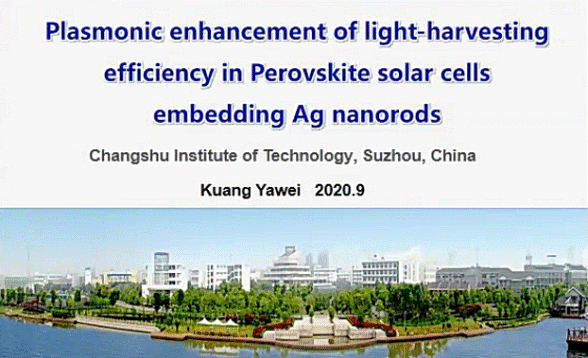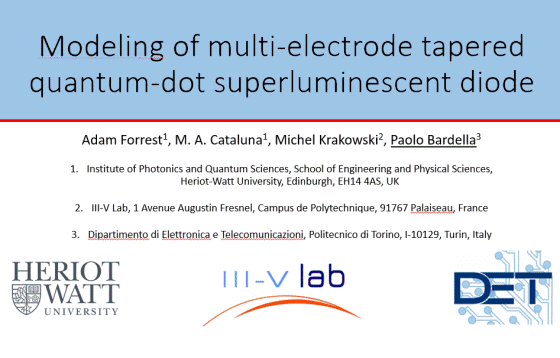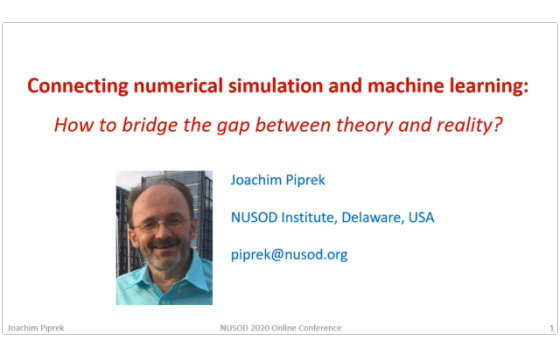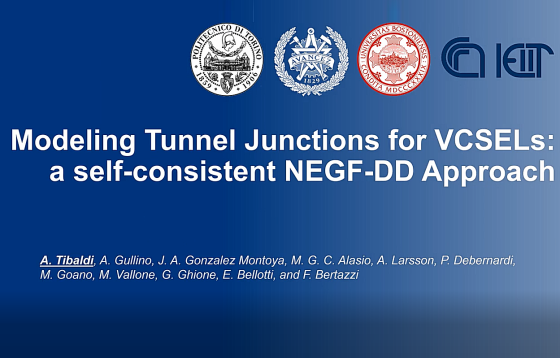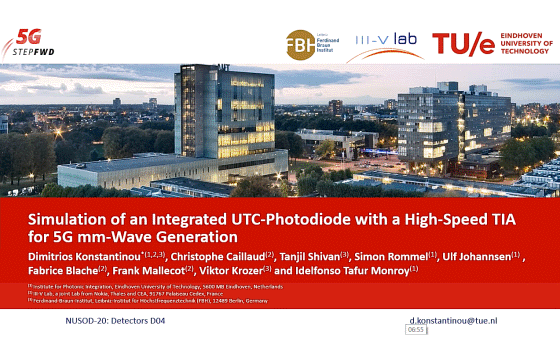


We present a comprehensive simulation flow for the estimation of photon detection efficiency as a function of wavelength in InGaAs/InP single-photon avalanche diodes (SPADs) at low temperature. We introduce a joint modelling of electrical and optical properties for SPAD detectors. We also highlight how accurately different parameters have to be calibrated in order to achieve […]
LD10–Dynamic properties of two-state lasing quantum dot laser for external optical feedback resistant applications
This work investigates the dynamics of two-state quantum dot lasers through semi-analytically solving a set of rate equations. Simulations reveal that the occurrence of excited state lasing reduces the damping factor of the laser while increases the linewidth enhancement factor associated to the ground state transition. These results are in good agreement with the experimental […]
IS04–Optoelectronic III-V nanowire implementation of a neural network in a shared waveguide
Neural node components consisting of III-V nanowire devices are introduced. This allows for the construction of a small footprint specialized neural network. A broadcasting strategy is developed which removes the need for inter-node wiring. As a model system, an insect brain navigational circuit is chosen and successfully emulated using the introduced nodes and network architecture. […]
SC07–Interpretation of a capacitance in polycrystalline solar cells: time domain simulations
In this work, we presented simulations of capacitance of polycrystalline solar cells using time-dependent calculations based on the finite element method. Our starting point was capacitance transient measurements of thin-film CIGS solar cells, which to this day, after twenty years of investigations, do not have the correct theoretical description. We showed, that there exists a […]
LD11–Influence of Coulomb Scattering on the Coupling between Longitudinal Modes in Nitride Laser Diodes
Due to their small separation of longitudinal modes, Fabry-Perot type laser diodes show rich mode competition effects. For example streak camera measurements show cyclic mode hopping, where the currently active longitudinal mode changes from lower to higher wavelengths. This effect can be explained by beating vibrations of the carrier densities in the quantum wells and […]
NM04–Atomistic analysis of band-to-band tunnelling in direct-gap GeSn group-IV alloys
The emergence of a direct band gap in Ge1-xSnx alloys has stimulated interest in developing Ge1-xSnx alloys and nanostructures for applications in Si-compatible electronic and photonic devices. The direct band gap of Ge1-xSnx, combined with the strong band gap reduction associated with Sn incorporation, makes Ge1-xSnx a promising material system for the development of Si-compatible […]
MM05–Project Skeletons for Scientific Software
Although research relies heavily on software packages such as mathematical libraries or data analysis tools, efforts to provide high-quality scientific software are hardly rewarded. As a possible way out of this dilemma, project skeletons can be employed to accelerate software development while ensuring code quality. In this work, we review existing project skeletons and present […]
LD07–Thermal Characterization of the Birefringence of Nematic Liquid Crystals for the Design of Widely-tunable LC-VCSELs
In this work, the thermo-optical properties of nematic liquid crystals are investigated through localized reflectance spectra measurements performed on a tunable LC-filter. The final aim is to insert such LC in the cavity of a tunable VCSEL device, in which local self-heating due to optical or electrical pumping must be taken into account. We demonstrate […]
IS05–Effect of Nonlinearities on Directed Optical Logic Gates Using Integrated Semiconductor Ring Lasers
Nonlinearities in the semiconductor ring laser (SRL) are incorporated in the analysis of directed optical logic gates and their effects on the output are studied. The paper discusses the effects of gain medium linewidth, internal quantum efficiency and self and cross gain saturation on the output of directed optical NOT gate implemented using SRLs.
SC08–The lateral photovoltage scanning method (LPS): Understanding doping variations in silicon crystals
The lateral photovoltage scanning method (LPS) can be used to detect undesired impurities which appear in silicon crystals during growth. Our goal is to make a digital twin of the LPS method. To this end, we replace inflexible blackbox code with a physics preserving finite volume discretization, confirming three theoretical results via a new simulation […]
LD12–Modeling Impact of Oxide Island on the Lasing of ARROW-VCSEL
We analyze the impact of a low-refractive antiresonant oxide island buried in a top VCSEL mirror on the lasing conditions of lateral modes of different orders. By performing comprehensive thermal, electrical, and optical numerical analysis of the VCSEL device, we show the impact of the size and location of the oxide island on the current […]
NM05–Simulation of electro optic modulators based on plasmonic directional couplers
In this paper, a new concept and geometry are proposed for plasmonic modulators, whose operation is based on the coupling between two plasmonic slots. An electro-optic polymer is exploited as an active material, and the device can be implemented within a Silicon Photonics platform. The device operates at 1550nm wavelength, typical of data center or […]
MM04–Completely Positive Trace Preserving Methods for the Lindblad Equation
The Lindblad master equation is a valuable tool in quantum mechanics, which describes the dynamics of open systems. In the scope of our research, it is combined with the one-dimensional Maxwell’s equations to form the generalized Maxwell-Bloch equations. Since analytical solutions are not available in the general case, numerical methods have to be employed to […]
LD06–Numerical Study of Optical Frequency Combs in mid-IR Quantum Cascade Lasers: Effective Semiconductor Maxwell-Bloch Equations
In this paper a theoretical model based on Effective Semiconductor Maxwell-Bloch Equations (ESMBEs) is proposed for the description of the dynamics of a multi-mode mid-Infrared (mid-IR) Quantum Cascade Laser (QCL) in Fabry Perot (FP) configuration, in order to investigate the spontaneous generation of frequency combs in this device. In agreement with recent experimental results our […]
PD01–Nanophotonic optical phased arrays: opportunities and limitations
Optical phased arrays can steer a beam without mechanical rotation, thus achieving a very rapid scanning rate. The core element of an optical phased array is the pixel (unit cell) and its ability to control the phase and amplitude of the emitted/scattered light. We discuss the role of nanophotonics in achieving pixels that are small […]
D01–Challenges in multiphysics modeling of dual-band HgCdTe infrared detectors
We present three-dimensional simulations of HgCdTe-based focal plane arrays (FPAs) with two-color and dual-band sequential infrared pixels having realistic truncated-pyramid shape taking into account the presence of compositionally-graded transition layers. Simulations emphasize the importance of a full-wave approach to the electromagnetic problem, and the evaluations of the optical and diffusive contribution to inter-pixel crosstalk indicate […]
SC09–Quasi-3D Optimization of Grid Architecture for Photovoltaic Converters Using Solcore
Numerical study of metal front contacts grid spacing for photovoltaic (PV) devices is presented with application to PV converter of relatively small size. The model is constructed based on the open source Solcore Python library. A three-step-process is developed to create a hybrid quasi-3D model. The optimal grid spacing was simulated at different temperatures to […]
IS06–Hybrid Electronic-Photonic Integrated Circuits: Hybrid FET-LET SRAM
High speed, low power, low leakage, and low noise circuits are extremely essential for modern VLSI chips. Since on-chip cache memories consume appreciable amount of the total chip area and energy, high performance and low power Static Random-Access Memories (SRAMs) are needed for high performance and low power electronic systems. A hybrid FET-LET 6T SRAM, […]
LED02–Luminescence and Internal Quantum Efficiency of Deep UV Light Emitting Diodes
Deep ultraviolet (DUV) light emitting diodes (LED) made of Aluminium Gallium Nitride (AlGaN) are increasingly considered as light sources for medical as well as material processing applications. Recent research on AlGaN DUV LEDs focuses on the enhancement of the efficiency. The efficiency of AlGaN LEDs is limited by a low hole injection efficiency and TM-polarized […]
MM03–Comparison of Scharfetter-Gummel Schemes for (Non-)Degenerate Semiconductor Device Simulation
We consider Voronoi finite volume schemes for the discretization of the van Roosbroeck system and pay particular attention to the choice of flux approximations. The classical Scharfetter-Gummel scheme yields a thermodynamically consistent numerical flux, but cannot be used for general charge carrier statistics.We compare and analyze aspects of two state-of-the-art modified Scharfetter-Gummel schemes to simulate […]
LD05–Optical Design Issues in Electrically Pumped Tunable Liquid-Crystal VCSELs
In this work we investigate a tunable 850nm laser based on a hybrid combination of a liquid crystal micro-cell and a half GaAs VCSEL. The target application is optical coherence tomography. The inherent tolerances of the hybrid technology, the presence of metals in the cavity and the need for a pure extraordinary mode lasing make […]
N04–Silicon-Integrated Red-Light Optical Gain Medium Based on BGaAs/GaP Quantum Wells
In this study we present BGaAs/GaP quantum well (QW) structures integrated with GaP/Si virtual substrate as a promising structure for applications requiring red-light optical gain media. Gain spectra are computed based on an 8-band k · p model with an envelope function approximation and Fermi’s Golden Rule. An emission of red light of wavelengths from […]
D03–Numerical Optimization of Quantum Cascade Detector Heterostructures
We demonstrate a Bayesian optimization framework for quantum cascade (QC) devices in the mid-infrared (mid-IR) and terahertz (THz) regime. The optimization algorithm is based on Gaussian process regression (GPR) and the devices are evaluated using a perturbed rate equation approach based on scattering rates calculated self-consistently by Fermi’s golden rule or alternatively extracted from an […]
SC10–Plasmonic enhancement of light-harvesting efficiency in Perovskite solar cells embedding Ag nanorods
Perovskite solar cells have attracted great attention in recent years due to its advantageous features including low production cost. Incorporation of plasmonic metal nanocrystals is a promising approach for broadening and enhancing the light harvesting of Perovskite solar cells. In this paper, we report a facile and versatile route to tune the photoresponse of perovskite […]
PD08–Supercontinuum generation with superior intrapulsecoherence in dispersion-tailored waveguides
Intrapulse coherence is an important performance metric for applications of supercontinua, including precision frequency metrology and attosecond science. These applications require a stable carrier-envelope phase, which is usually measured by f–2f interferometry. Here, the potential for superior intrapulse coherence with 100 and 400-fs input pulses is studied, exploiting different dispersion profiles. The simulation results in […]
LED03–Modeling of multi-electrode tapered quantum-dot superluminescent diode
We introduce a rate equation based numerical model suitable for the description of the wide spectral asymmetry experimentally observed at the two facets of multi-electrode tapered superluminescent diode based on Quantum Dot material. Numerical simulations carried out with this model were able to quantitatively reproduce the behavior of a two-section SLD and explain the reported […]
MM02–Connecting numerical simulation and machine learning: How to bridge the gap between theory and reality?
Machine learning and numerical simulation represent opposite approaches to computational analysis of the real world, inductive vs. deductive. However, both methods suffer from various uncertainties and even their combination often fails to link theory and reality. This paper presents a critical review of such connections and proposes improvement options for optoelectronic devices.
LD04–Modeling Tunnel Junctions for VCSELs: A Self-Consistent NEGF-DD Approach
In this work we investigate carrier transport in tunnel junctions for vertical-cavity surface-emitting lasers by a novel self-consistent simulation framework for semiconductor quantum devices. Based on a Poisson-drift-diffusion foundation, in this approach quantum features are described through a nonequilibrium Green’s function formalism. The simulator is validated through a comparison with experimental results.
NM01–Ferrimagnetic garnets for integrated non-reciprocal devices
Ferrimagnetic garnets are promising materials for applications in integrated non-reciprocal devices due to their low optical absorption and relatively large magneto-optical response at telecommunication wavelengths. However, their implementation into phonotic chips is rather difficult due to large lattice parameters and thermal expansion mismatch with common photonic substrates. In this talk, we present our latest progress […]
D04– Simulation of an Integrated UTC-Photodiode with a High-Speed TIA for 5G mm-Wave Generation
This work introduces a subsystem level cosimulation for generation, boosting and transmission of millimeter wave signals for 5G applications. The simulation processes to model the full equivalent circuit of uni-traveling carrier photodiodes based on reflection coefficient measurements are analyzed. The optoelectronic lumped equivalent is co-integrated with a transimpedance amplifier design synthesized by high speed transistors. […]

